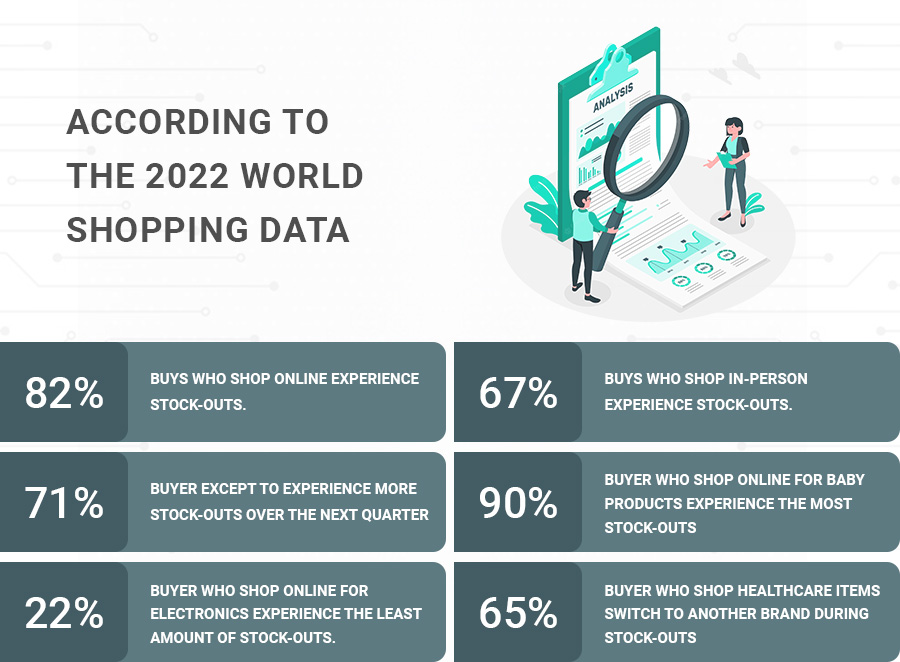Stockout or out-of-stock is a business sin. What is stockout and how can it be avoided? This blog will teach you all you need to know about Stockout, including its causes, effects, techniques, and remedies. In simple terms, a warehouse inventory control system can help you to predict future market trends and prepare strategies accordingly to avoid stockouts.
The Stockout Rate is simply the proportion of items that are out of stock when customers wish to buy them. The Stockout Rate may be calculated simply by dividing the number of things not in stock by the total number of items in stock. One of the leading 3PL company in India like AWL India conducted comprehensive research and discovered that the average stockout rate throughout the world is more than 8% and continues to rise. 8% may seem like a little percentage to some, but in bulk order processing and over time, it translates in significant income loss for firms.
Key Takeaways
- Understand the reasons why Stockout happens.
- What are the consequences of Stockout?
- What does it cost your business?
- How Covid-19 pandemic accelerate the Stockout Rate throughout the world?
- How to prevent your inventory from Stockout?
Reasons Behind Stockout
Stockouts occur due to a variety of factors, including inefficient cash flow management, a shortage of working capital in the organisation, supply chain delays, an inability to generate an acceptable amount of stock relevant to market demand, and a variety of other replenishment concerns. Furthermore, it has been discovered that over 70% of stockouts are caused by shops purchasing too late or too little. The remainder of stockouts are caused by non-replenishment and inadequate inventory stock management system. Sometimes enterprises underestimate the market demand for their products, resulting in a scarcity and even a low level of safety stock. We've also discovered that many organisations have ineffective order management systems and limited order processing capabilities. Aside from these factors, poor product quality, incorrect lead time, and last-day delivery are also acknowledged causes of stockout.
Consequences of Stockout
Customers' pleasure declines when they do not receive what they desire. Customers are more likely to search elsewhere for the things they require if you don't have them on hand, therefore stockouts may result in missed sales and revenue loss for your company. They are less inclined to return to your items and look for alternatives to the same thing. If you have a monopoly in the market, you can receive some respite, but that is an uncommon occurrence in today's market. Let's go through the repercussions of Stockout in depth.
Buyer Need To Wait
Buyers may be willing to wait if the item is critical to them and they have no other options. Despite this readiness, the customer's level of pleasure may suffer significantly. This not only tarnishes their desire in purchasing from you in the future, but it also makes them uninterested in investigating your other items and services.
Customers’ Backorder Items
This is a worse case scenario, and it is not as good as when the consumer agrees to wait for the order. Even if the consumer orders the out-of-stock item from you in the hopes of receiving it as soon as it becomes available, the level of client satisfaction remains low.
The Customer Withdraws The Order
This is the worst-case situation, in which the buyer cancels the transaction and begins looking for another supplier, especially if the item is required quickly. It's still conceivable that the customer may make another purchase with you in the future, but the chances are small due to the consumer's previous negative purchasing experience with you.
The Customer Starts Shopping Elsewhere
This is the final thing that can go wrong with your company's sales. Consumers may be motivated to break all connections with you and interact with other companies due to poor communication or incorrect information supplied by your sales team regarding available inventory for purchase. Also, I will never buy with you again!
How Bad Is Stockout for Your Business?
Let us first put ourselves in your buyer's shoes to comprehend the repercussions of out-of-stock and why consumers nowadays are so satisfied with businesses that do not fulfil their order expectations. Assume you have a consumer who is buying your items and has been saving up for the item he or she spotted on your online/offline store. S/he is overjoyed to finally have enough money to buy that special product, only to realise that it is now out of stock! Yes, your consumer is now irritated, disillusioned, and unmotivated to continue shopping with you. This is what is going on in the consumer's head during the Stockout situation, and it is costing you more than you realise. Let's go over exactly how your business will suffer as a result of this.
Losing Sales and Business Revenue
Inventory management is the most important procedure, and inventory is the most important asset for your company if you manufacture and sell things. It's a really easy and fundamental concept to grasp. You make money by selling your items, and if you run out of them, your consumers won't be able to buy them, reducing your revenues. When you run out of certain items that your customers want, your company loses roughly half of its planned orders. If you are a billion-dollar corporation or shop, losing 4% of sales every year equals $40 million in losses that you might have avoided by enhancing your production capacity and implementing better inventory management.

Tarnishing Your Brand Image
We all have the inclination to quit purchasing a product we used to appreciate because it is regularly out of stock. And it's not just the unavailability of goods that's giving your customers a negative experience; it's also how your purchasers have come to see you as an irresponsible brand. A bit paradoxical, but Stockout often provides the sense that the product is so wonderful that it sells out rapidly, but it also gives the idea that you are unable to mass manufacture and do not understand your consumers' needs. Worse, once a negative impression is formed in the minds of your clients, it is extremely difficult to regain the reputation your brand has lost.
They are driving away from you and toward your rival! Overall, if you don't respond promptly and make judgements to avoid stockouts, your consumers will develop an unfavourable image of your brand and may persuade others not to purchase from you.
Covid-19 Pandemic and Stockout around the World
Consumers and businesses have suffered shortages in a wide range of goods, from toiletries to cars, since the virus outbreak began in 2020. COVID-related supply interruptions have been noted by numerous economists and policymakers around the world as a potential source of the rise in prices of goods. However, there has been little empirical evidence of the magnitude of shortages across various categories of consumer products, as well as whether they have an impact on retail prices and inflation dynamics. Our new study, which looked at significant retailers with both online and physical storefronts, provides a more detailed picture of the nature of product shortages and their link to price increases.
Take Right Measures and Prevent Inventory Stockout
More than 40% of buyers believe Stockout reduces their shopping interest and experience. However, there are several steps you may take to avoid stockouts and avoid harming your customers' feelings as well as your company's revenues. Taking the necessary steps to better understand your business and goods, as well as streamlining your operations, can assist you in avoiding stockout. Let's go through it in depth.
Incorporate Artificial Intelligence-driven tools
AI-driven technologies have grown and altered the business sector during the previous decade. We all utilise Artificial Intelligence in some capacity. Using AI-powered applications may also ensure that your company has a centralised repository for all of its inventory data. To avoid running out of supplies, just embrace the most recent technology and maintain it up to date. Many supply chain warehousing consulting systems now offer automated inventory replenishment, supplier management, sales monitoring, labour automation, and other digital tasks. Inventory management with Artificial Intelligence software becomes a piece of cake when you have full monitoring of all your activities in one spot.
Boost Your Logistics
Because of regular lockdowns, changes in export/import rules throughout the world, and port constraints, a seamless supply chain has become a concern for enterprises all over the world. When oil prices soared, and hence the pricing of products, the scenario got more acute. To minimise foreign limits, try to source your components or products locally or domestically. You should also implement a robust supply chain method, including distribution and transportation, to guarantee that everything works well and there are no logistical delays.
Maintain Organised Operations
While automation helps manage inventory in a virtual sense, correctly structuring corporate procedures is also incredibly advantageous. Despite its insignificance, one of the most crucial ways for avoiding stockout is to have structured mechanisms at work. Physically organising inventory operations not only guarantees that no item is lost due to theft or damage, but also allows you to physically inspect and visualise the inventory, which may assist you in avoiding stockouts. Spend some time cycle counting to see whether what's on the systems matches what's in the shop.
Predicting Resilience
Demand forecasting in advance may dramatically transform your warehouse and supply chain management firms in india. Researching and analysing data to determine which of your items is in great demand can aid you in increasing output and ensuring that manufacturing runs efficiently to minimise stockouts. Over 70% of organisations struggle to forecast inventory demand because they lack comprehensive automation in inventory management and product manufacture. Today's technology and modern software may assist you in obtaining every demand and supply knowledge so that you can readily examine your subsequent business activities and avoid human mistakes.
Manipulate the Market's Demand
This may look unethical to certain firms, but it is not. If you anticipate that demand for a product will increase and that you will run out of inventory soon, you may moderate demand by raising the price slightly. Some may find it counterintuitive, but the fact is that businesses gain more money from inventories after boosting commodity prices, and mass production stress is not applied to production. Perform frequent analysis to determine whether items are running low and may be utilised to boost the price. Create reorder points as well, so you know when to restock your best-selling inventory. The sole advice is to avoid doing it too frequently and on all items. Examine your prior sales and devise prices that will not drive your clients away indefinitely.
Conclusion
Inventory management is crucial for long-term performance and profitability regardless of industry. You may generate an inventory trend report, automate reorder points, check inventory counts at the SKU level in real time, and make forecasts. Stock control methods may be developed using sophisticated and accurate inventory management software to aid you in maintaining a healthy inventory turnover and keeping your stores stocked with the right number of things.

Depreet Singh
Warehouse Manager




